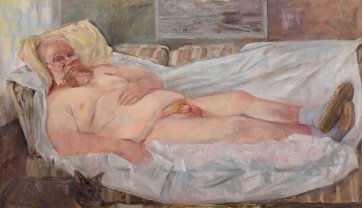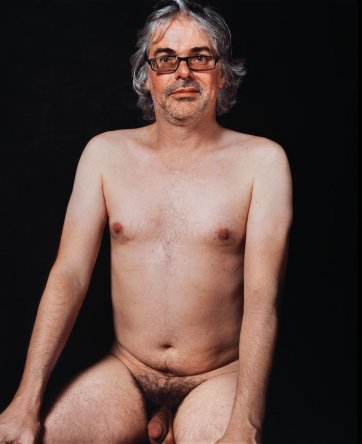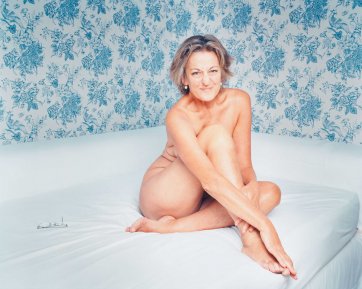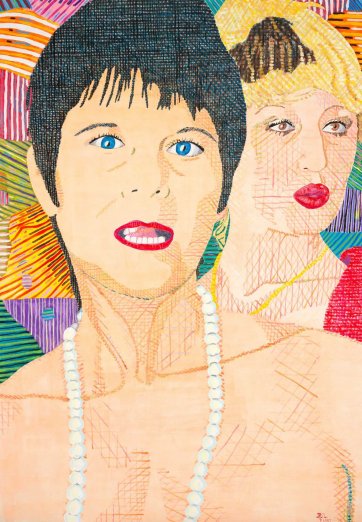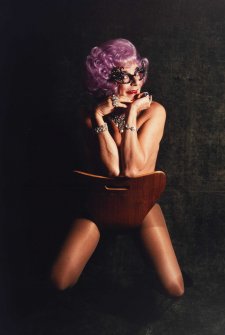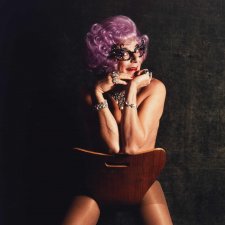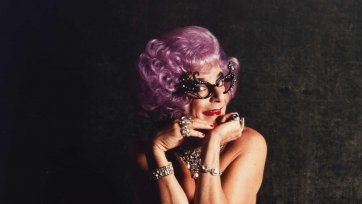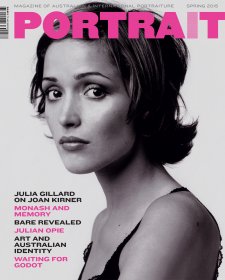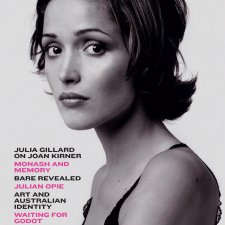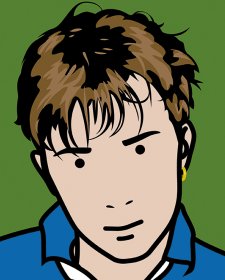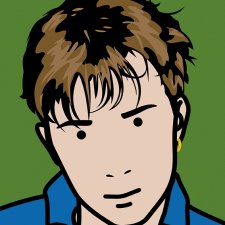The freedom of privacy in Bare: Degrees of undress
Bareness is deliberate. ‘Bare’ is the word we use for the exposed parts of the body that are supposed to be naked – feet, hands and babies’ bottoms. Bareness is a chosen degree of dress somewhere between the clothed public self and unclothed private self. Modern portraiture is a public form, but reveals something of the sitter’s private life. In Bare: Degrees of undress, the National Portrait Gallery has brought together almost all of the portraits in its collection where sitters appear in degrees of undress. Within the exhibition, the portraits are arranged according to the role that bareness plays in enunciating something about the sitter’s humanity or identity.
This article examines seven portraits within Bare, and considers how they negotiate a sense of ‘public privacy’ – the revelation in a public portrait of those parts of the body and elements of life usually located in the private sphere. Sexuality, intimacy, personality, anxiety and imagination have traditionally dwelt in private life, and been embodied in nakedness. In this sphere of the unconcealed body, emotion and hope, doubt and uncertainty appear on the surface of modern portraiture that seeks to reveal something of sitters’ inner lives.
The notion of privacy itself is popularly regarded as ‘under siege. In his introduction to the fifth volume of the landmark study, A History of Private Life(1991), Antoine Prost observed: ‘Private life is not something given in nature from the beginning of time. It is a historical reality …. The boundaries of private life are not laid down once and for all.’ Jose Antonio Vargas observed in his New Yorker profile of the founder of Facebook, ‘Zuckerberg’s business model depends on our shifting notions of privacy, revelation, and sheer self-display.’ Zuckerberg himself frequently speaks of the new ‘social norm’ of sharing. And in 2008, Clive James postulated that a ‘private life may be becoming impossible to lead.’
In portraiture, at least, sharing is a designed, controlled and constructed revelation. This may explain the fact that almost ninety per cent of the portraits in Bare represent sportspeople, dancers, actors and musicians – society’s performers. It may also explain the complete absence of any sense of shame or embarrassment in the exhibition. Bareness is not as refined a garment as the nudity historian Seymour Howard called ‘the most subtle and sophisticated form of clothing’.
Nor is bareness as spiritual or primal as the nakedness that is ‘under all those wool-rags, a Garment of Flesh … contextured in the Loom of Heaven’ as Thomas Carlyle’s fictional Herr Teufelsdröckh described it in Sartor Resartus. In portraiture, bareness is a costume for a public performance of privacy.
Matthew Mitcham is cast in The Fall of Phaeton
Ross Watson places the smooth, sculpted, athletic, nude body of Olympic diver Matthew Mitcham in the world of Sebastiano Ricci’s 18th century Fall of Phaeton. Art historian Michael Jacobs noted that artists from the Renaissance onwards often turned to ‘classical mythology as a fresh, humorous and erotic alternative to religious art’. In an ingenious appropriation of this tradition, Watson embraces the wild ambiguity of classical allusion. Mitcham appears with Phaeton, the son of Helios, who hurtles earthwards, out of control after insisting on driving his father’s sun-chariot across the skies, the victim of youthful overreach. When the portrait was painted in 2009, the bravery of youth sustained the dramatic parallel.
Aged twenty, Mitcham was one of a handful of openly gay athletes at the 2008 Beijing Olympics. ‘Being in an Olympic Village is like being in a utopian prison’ Mitcham told journalist Laurence Watts. ‘Everyone is happy, ripped, buzzed and beautiful.’ In the 10m platform diving event, Mitcham received the highest single-dive score in Olympic history. It was his sun-chariot moment. His arm scarred from teenage self-harm, Mitcham has long struggled with clinical depression. In private, the following years saw his fall from the heights of Olympic stardom to a destructive drug-addiction, revealed in Mitcham’s 2012 autobiography, Twists and Turns, and his one-man cabaret show of the same name, touring in 2015. A portrait can become a public scene into which the rest of the private script can be read. It is the metaphor of personal resilience that is almost prescient: as young Phaeton falls to the earth to be buried by nymphs, Mitcham appears to soar upwards.
And the weaver said,
Speak to us of Clothes.
And he answered:
Your clothes conceal much of your beauty,
yet they hide not the unbeautiful.
And though you seek in garments
the freedom of privacy
you may find in them
a harness and a chain.(from The Prophet, by Kahlil Gibran)
Naomi Watts stars as a Victorian innocent
In this portrait of actor Naomi Watts, photographer Peter Brew-Bevan plays on the nineteenth century genre-painting standard of the young lady posed dreamily in her boudoir. The Victorian obsession with innocence carried a hint of eroticism. Watts has been often cast in grim, intense thrillers and horror movies – ‘Yeah, grimerama’, Watts agreed with one journalist, also expressing the view that confronting one’s private fears on screen has some value. The Victorian era was the golden age of the ‘sensation novel,’ and the ghost story in which private lives harboured fearful secrets – these books were a guilty pleasure for Victorian ladies. Brew-Bevan recalled Watts’ instant engagement with the concept of the portrait shoot and was struck by ‘her innate beauty [and] her fragility … She is very petite – almost childlike.’ While Watts, in a state of deshabille, is utterly immersed in the scene, she looks straight into the camera as a Victorian heroine never would.
Michael Boddy appears as the Venus of Urbino and Olympia
Michael Boddy’s performance of a classic art historical pose in this deeply personal, affectionate portrait by his wife, Janet Dawson, reminds us that even the most intimate portrait is a scene of public privacy. In 1538, Titian painted the Venus of Urbino, an allegory of marriage with the goddess of love reclining, a dog at her feet symbolising fidelity. A courtesan held this same pose in Manet’s Olympia; the defiant reality of an individual woman sitting in place of an allegorical goddess provoked scandal in 1865.
These allusions are apt in the portrait, Summer 1986. Michael Boddy, director, playwright, actor and columnist was a unique and trail-blazing figure in 1970s Australian new wave theatre. As a modern Australian allegory of marriage, this figure in spectacles, socks and slippers on a hot summer day could not be more perfect. Dawson collaborated on Boddy’s productions as a designer, and in 1973 won the Archibald prize with his portrait, clothed. Boddy once said of his life with Dawson: ‘Our marriage is one long conversation.’
Boddy explained how Summer came about: ‘It was painted alla prima in one session on a very hot day. I was asleep on a sheet on the studio couch. Janet, my wife, came in to get a large stretched canvas to do a landscape. I said it was big enough to get all of me into it, plus the dog; a human landscape.’ Boddy’s ‘only stipulation’ is interesting: ‘I should be awake, conscious of the viewer, and not all welcoming’. He was the lead actor in this warm and honest private scene.
Pat Larter embraces the role of an artist’s nude model
This collaborative production within the context of a personal relationship is Richard Larter’s portrait of his wife, performance artist Pat Larter, posed in front of another of Larter’s paintings. Richard Larter painted thousands of nudes, using his wife as his model, over many decades. The work blurs the bounds between the contemporary art of the nude, performance art and portraiture. In an oral history, Larter recalled: ‘I started drawing nudes, using my wife as a model; I was virtually doing a private record of my wife – I enjoy drawing nudes, and then there’s the perverse side of it – I know that they upset people, they upset my mother, and she was the first person to be upset, and then as I started to exhibit and send pictures away, people started writing and saying things about the nudes, and then I think this made me a little more daring, so instead of being discreet nudes they became very indiscreet nudes. I suppose I’m healthily sexual, as most people are, but unlike most people I don’t feel ashamed of it … ’
In 2005, writing in Politics and Culture, Joanna Mendelssohn observed that Pat’s performances within the works shocked because of their ‘unsentimental sexuality’. In a 1992 Art and Australia article, Mendelssohn quotes Larter: ‘Getting a likeness that can actually say something … You can only do that with somebody you know really, really well. You’ve got to have an interaction between the model and the painter, and the only person I could be assured of is Pat.’ Among Richard Larter’s favourite quotes, recorded on the back of an envelope for curator Christopher Chapman in 1995, is Pat’s question: ‘If we live in our heads, why is the voyeur looking out?’
Leigh Bowery performs Lucian Freud’s Large Head
This portrait of a performance artist, on loan to the National Portrait Gallery, is an etching of Leigh Bowery by British artist Lucian Freud. Humans are ‘two-legged animals without feathers’ according to Diogenes Laërtius’ quotation, attributed to Plato in the third century AD. For Freud, bareness is an animal costume: ‘I’m really interested in them as animals. Part of liking to work from them naked is for that reason. Because I can see more … One of the most exciting things is seeing through the skin, to the blood and veins and markings.’ Freud rarely titles his naked portraits with the name of the sitter – Bowery’s portrait is titled Large Head. At the same time, Freud’s portraits portray viscerally individual people, as he has said: ‘Human, tired, they are the thing which they themselves feel is essential to them.’ Martin Hammer observes that ‘Freud is driven not just to evoke the aura of the individual nude people, but also to attain a more fundamental idea of the naked truth.’
Androgynous pop star Boy George, for whom he designed costumes, called Bowery ‘modern art on legs.’ Bowery was a designer, musician, artist, performer and the face of the London Club ‘Taboo’. Having grown up in Sunshine, Melbourne, Bowery became famous in the creative fringe of the 1980s London clubbing scene. Transgressive, exuberant, shameless, Bowery was ‘creating a new being’, as William Lieberman put it. Freud met him in 1990 at Anthony d’Offay Gallery, following a performance piece where Bowery dressed and preened behind a one-way mirror. He sat frequently for Freud over the next four years, before Bowery died of an AIDS-related illness, aged only thirty-three. ‘I realised the fact that he was a performer meant that whatever he did, he was still in a sense performing,’ reflected Freud, ‘because of his physical awareness, which was extraordinary. And very articulated. And – huge as he was – very delicate.’ These quiet, stripped-back portraits are deeply moving. In his survey of Freud’s work, Sebastian Smee highlighted Freud’s ‘understanding of other people’s privacy, their essential solitude.’
David Walsh as the director of a controversial new museum and Germaine Greer as the playful 61-year-old lady
A quote from Friedrich Schiller is the inscription on Gustav Klimt’s 1899 allegorical painting, Nuda Veritas (‘naked truth’): ‘If you can’t please everybody with your deeds and your art, please only few. To please many is bad.’ It would be an equally apt inscription on both Polly Borland’s portrait of Germaine Greer and Andres Serrano’s portrait of David Walsh – two of the barest sitters in Bare. Their costumes of bareness match their deliberately cultivated personas – controversial, uncompromisingly unconventional and outspoken. As if to emphasise the artifice, Greer keeps her earrings on and Walsh his glasses.
Taken in New York in 2010, this portrait of David Walsh by Andres Serrano was the last image in the book Monanisms, published to coincide with the opening of his Museum of Old and New Art (Mona) in Hobart, Tasmania. Mona is a public art museum displaying Walsh’s private art and antiquities collection, and Walsh courted outrage in interviews describing it as ‘a secular temple’ and ‘a subversive adult Disneyland’. According to some accounts, he was momentarily disappointed when it was embraced more than reviled. A naked portrait of its founder could not have been a better metaphor for this exercise in making the private public.
One of America’s most mythologised contemporary artists, Serrano has said: ‘Both my supporters and my critics seem to be disappointed when I am not especially provocative.’ His 1992 work The Morgue (Blood Transfusion Resulting in AIDS) is in the Mona collection. As is the case for Lucian Freud, Serrano’s subjects are both emphatically individuals and ‘a way of exploring ideas’: ‘All of my life, all of my career, I’ve used portraiture,’ Serrano told an interviewer, ‘as a way of looking at religion, politics, race, poverty.’
Richard Flanagan wrote in The New Yorker that Mona: ‘is a museum … of doubt and questioning, of despair and wonder … Certain only of its own uncertainty, it touches something of now.’
‘I’m not sure that art is so important for me,’ Walsh told Flanagan. ‘It is the relentless dissecting of myself to bring me closer to an understanding of why I do what I do that seems to be important to me.’ One reason Walsh, a mathematically brilliant master gambler, gives for using his winnings to found Mona, is ‘to absolve myself from feeling guilty about making money without making a mark.’ Since this portrait was taken, Walsh has become publicly more earnest about his achievement – an earnestness Serrano managed to capture in this portrait.
The 1970s feminist movement’s catch-cry, ‘the personal is political,’ sought to collapse a distinction that implied entrenched, gendered power relations. ‘Maybe I don’t have a pretty smile, good teeth, nice tits, long legs, a cheeky arse, a sexy voice,’ declared Greer in what was to become, world-wide, the best known work of second-wave feminism, The Female Eunuch, published in 1970. Bareness was Greer’s preferred costume for her photoshoot: ‘It was my idea to take my clothes off … because I did not fancy being portrayed on my bed like an old lady in a nursing home in me [sic] cardigan.’ Quoted in Polly Borland’s Australians exhibition catalogue, she continued: ‘I don’t usually have any clothes on in that room and I don’t have any clothes on for a good half of my life. The photograph is really quite childlike. I think there is a certain amount of playfulness in it. It might surprise people to discover that sixty-one year-old ladies can be playful.’
Greer has spent a lifetime engaged with private issues publically, accentuating discomfort to provoke debate. ‘Portrait photography reveals something about the nature of being alive,’ says Polly Borland. ‘The best portraiture is when you get beneath the skin of someone.’ Borland captures more than Greer’s cheeky expression and predictable bareness, touching on something more private. Greer told Andrew Denton in 2003: ‘principally,
I think happiness comes from being un-self-conscious – just forgetting about yourself.’ Her portrait is more than a public performance; it hints at a personal and quite conventional belief about life.
A public privacy
The clear control over one’s own exposure is one of the most emphatic statements of self that can be made. The intersection of privacy and control resonates throughout Bare, and bareness becomes an assertion of freedom to wear this costume.
In A History of Private Life, Antoine Prost sees the modern sense of privacy as contingent upon control over the self: ‘self-realisation crucially involves the freedom to grant or to withhold access to oneself or the capacity to reveal or conceal aspects of one’s being as one chooses.’ He quotes philosopher Jeffrey Reiman’s assertion that ‘a precondition to personhood’ is ‘an exclusive moral right to “shape” your own destiny.’ As technology blurs or erodes the public-private divide, perhaps the metaphor of sitting for a portrait in the deliberate costume of the bare fortifies the inner sanctum of the self.


